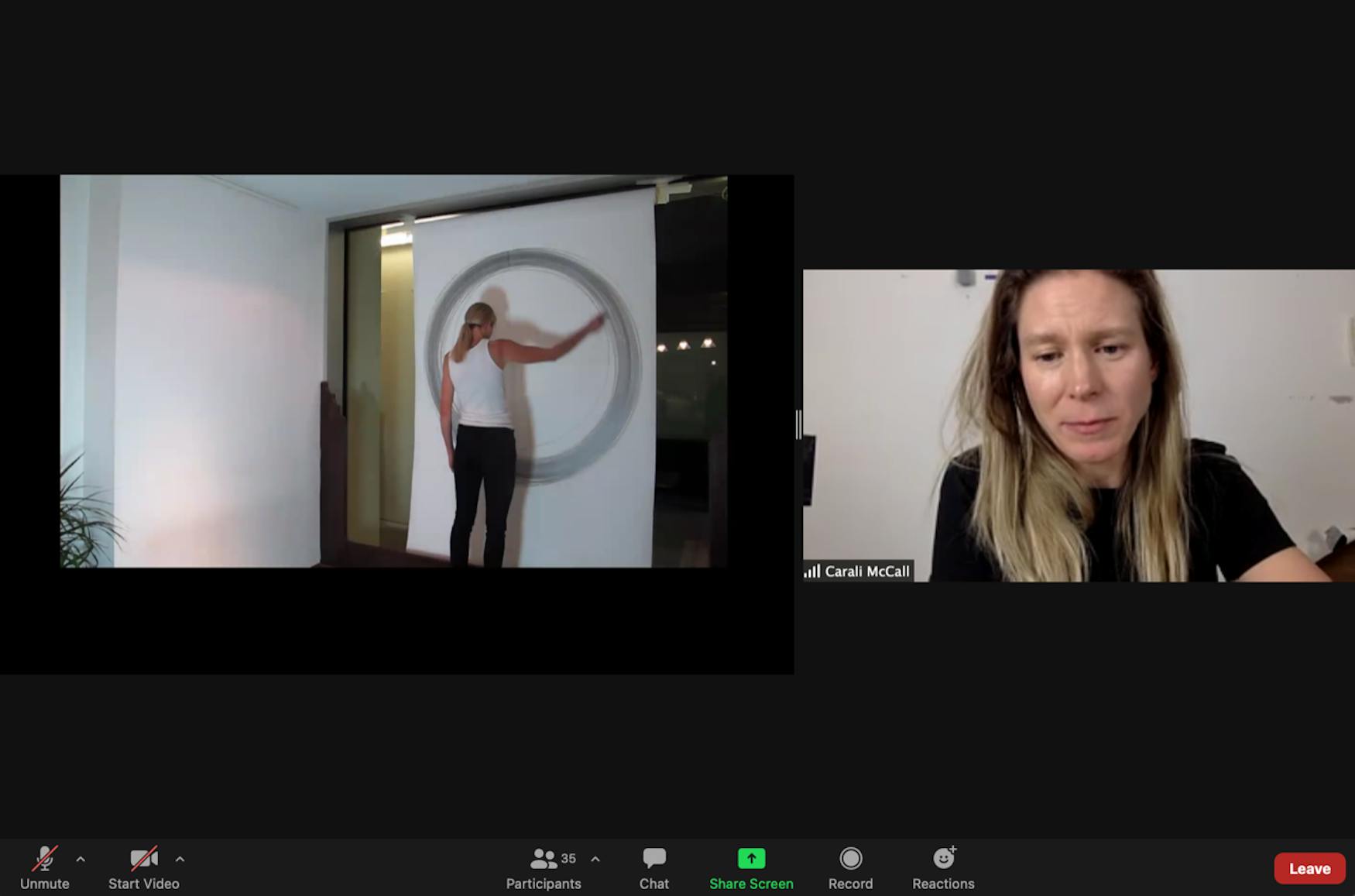Drawing without visible trace: when acts of drawing and running become a performance
On April 6, Carali McCall, a London-based artist and co-author of “Performance Drawing: New Practices since 1945,” gave a virtual talk as part of the “Brandeis Post Baccalaureate in Studio Art Lecture Series.” McCall is fascinated by the passage of time, physical energy and bodily movement. Her research and artwork question an artist’s role and uncover new ways to understand the body. She explores the performative nature of human activities and demonstrates how the act of drawing can become a tool of performance. In this relaxing talk interspersed with video clips of her performance work, McCall charted her journey as an artist and the development of her vibrant and expressive practice: the “performance drawing.”
McCall grew up on a farm in Canada. Fluffy snow covered the fields in winter, creating an expansive poetic world of white, where only the ambiguous horizontal line in the distance separated the vast sky and flat terrain. She ran regularly on a predetermined route and used landmarks such as trees and electric poles to measure the distance she travelled. The act of running resembles drawing, McCall explained, leaving impermanent marks across the landscape. This early memory as an energetic runner sparked inspiration in her art practice, and she began to explore body strength, physical limits and the potential connection between movement and drawing.
McCall studied photography and sculpture as an undergraduate. She earned her master's degree at the Slade School of Fine Art and doctorate at Central Saint Martins College of Arts. The rigorous research she did in Art History and Philosophy allowed her to consciously trace the trajectory of artistic practices and search for past artworks that resonated with her. She relished in the context of the art studio where she experimented with the body as a material in her artworks. McCall said that she usually introduced herself as an “academic artist,” since “academia, art school and [her] tutor side…[have] been a big part of [her] background and [have] also [been] a big influence [on her].”
The “Work No.1 (Circle Drawing)” displayed in a student show in 2004 is McCall’s first piece of performance-based work in the circle drawing series, where she married performance and drawing. Her performances consist of drawing large, full-arm-length circles on a large-scale paper mounted on a wall or floor in front of a live audience. She draws in a sustained manner for about three hours until she exhausts her energy and can no longer hold the graphite. The swooshing sound from the drawing creates a hypnotic rhythm, resembling the pace of a marathon runner. The resulting piece is striking, satisfying circles superimposed over one another in an unbroken line. McCall said that unpredictable incidents sometimes occur when traces of blood from her fatigued hand imprint the surface, and sometimes the paper tears. In this sense, it is the performance of drawing rather than the final motif on paper that becomes the core of her art, directing the viewer to explore the literal and metaphysical relationships between the body, time and space.
McCall has always valued collaboration. She remarked that just like bands create fabulous performances, “artists creating something together is more powerful.” In 2012, McCall collaborated with Jane Grisewood to produce a performance drawing titled “Line Dialogue V” in an exhibition at the Vancouver Art Gallery. Based on the early idea of the “Circle Drawing” to test the reciprocity between body and movement, the performance further examined the concept of collaboration and communication. McCall noted that it is always important to establish communication with other artists, especially now that the pandemic has forced many artists to work in isolated studios. She shared with the audience some of her correspondences with other artists and showed how they encourage and support each other in artmaking.
Besides collaborating with others in performance, McCall co-authored an academic work with three artists she met while pursuing their practice-based PhDs. In 2020, Bloomsbury Visual Arts published a piece titled “Performance Drawing: New Practices since 1945.” It is an academic book that introduces the evolution of “Performance Drawing” and aims to illuminate the questions of “what is drawing” and “what is performing” in contemporary practices. McCall noted, “this is a book that she wishes [had been there] there when she set off [on her career].”
When does running become drawing? The commonality between running and her performance drawing, both repetitive and durational processes, led McCall to further define the relationship between running and drawing. McCall’s recent projects use a video camera to record her experiences running through different landscapes and public areas. She employs running as an artistic device to articulate the form of drawing and explores the notion of endurance through the long and exhausting process of exercise. As her body moves across the roads and streets, it seems to delineate imaginary lines. She experiences drawing through running as she experiences the speed and distance in her performance drawing. Both processes open up questions and tap into a way of thinking about the body. McCall’s thought-provoking projects push drawing beyond its traditional limits as a static, two-dimensional form and endow the activity of drawing with a novel, radical definition.
McCall’s ideas about the act of drawing and running are intriguing. In daily activities, people often focus on the specific tasks and forget the very presence and physicality of the body, which energizes our movement and sustains the spirit. McCall’s works reconceptualize the body as an instrument of perception and exploration of the world. Oscar Wilde once remarked, “life imitates art far more than art imitates life.” Simply put, even though art is derived from life, it constantly affects how people perceive and understand the world. This quote could be applied to describe the power and influence of McCall’s performance art, which redefines drawing and reshapes our physical embodied experiences of everyday act.



Please note All comments are eligible for publication in The Justice.